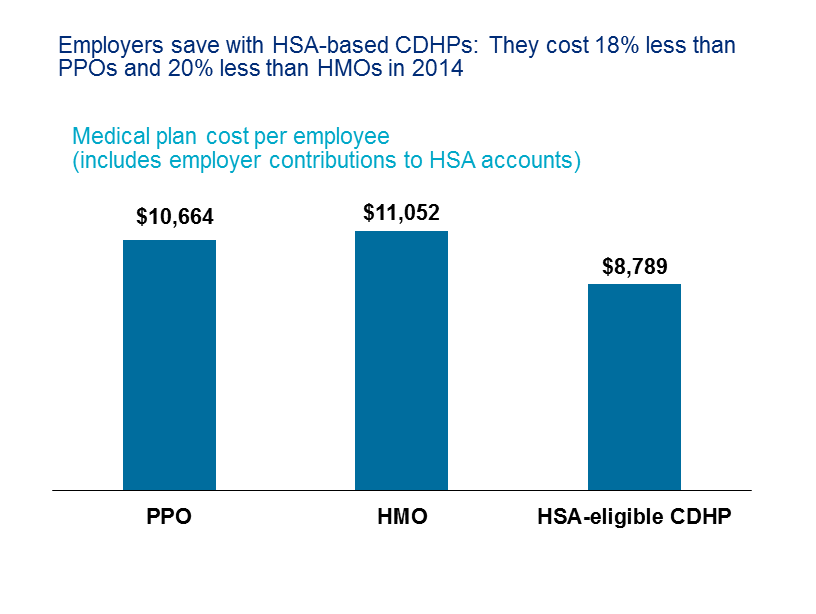Consumer Directed Health Plans (CDHP) Put The Breaks on Health Spending
A big news story last week was the CMS report on the slowdown in spending on health care in the US in 2013, which the authors attributed in part to a shift to high-deductible consumer-directed health plans (CDHP) in the private insurance market. Our response to that? Just wait until you see the numbers for 2014! As we reported last month, results from Mercer’s National Survey of Employer-Sponsored Health Plans for 2014 show the largest one-year jump in CDHP enrollment, from 18% to 23% of all covered employees. (This followed 2013’s more modest growth in enrollment, from 16% to 18%.)

A big news story last week was the CMS report on the slowdown in spending on health care in the US in 2013, which the authors attributed in part to a shift to high-deductible consumer-directed health plans (CDHP) in the private insurance market. Our response to that? Just wait until you see the numbers for 2014! As we reported last month, results from Mercer’s National Survey of Employer-Sponsored Health Plans for 2014 show the largest one-year jump in CDHP enrollment, from 18% to 23% of all covered employees. (This followed 2013’s more modest growth in enrollment, from 16% to 18%.)
Employers of all sizes, but especially large employers, added CDHPs in 2014. Offerings of CDHPs jumped from 39% to 48% among employers with 500 or more employees, and from 63% to 72% among jumbo employers (those with 20,000 or more employees). While the use of CDHPs has been growing steadily, the trend has accelerated as employers anticipate growth in enrollment in the post-reform era. (As the graph above shows, 66% of all large employers, and 88% of the jumbos, expect to offer a CDHP in 2017.) In 2015 the ACA provision goes into effect requiring employers to extend coverage to substantially all employees working 30 or more hours per week. Well over a third of large employers (38%) were affected by this rule and will need to extend coverage to more employees as a result. What may drive up enrollment still further is that employees who have chosen not to elect coverage in the past now have a stronger incentive to do so — as the minimum tax penalty for not obtaining coverage rises to $325 for 2015 from just $95 this year.
CDHPs offer employers a way to mitigate growth in spending as they cover more employees. The average cost of coverage in a CDHP paired with a tax-advantaged health savings account is 18% less than coverage in a PPO and 20% less than in an HMO: $8,789 per employee, compared to $10,664 for PPOs and $11,052 for HMOs.

These plans are also a top strategy for employers looking for ways to avoid paying the “Cadillac tax” in 2018 — a 40% excise tax on health coverage that costs more than $10,200 for an individual or $27,500 for a family. Mercer estimates that about a third of employers are currently at risk for triggering the tax in 2018 if they make no changes to their most costly plan.
While new plan implementations are driving up CDHP enrollment, we are also seeing growth in enrollment in existing plans as employees become more comfortable with consumerism and employers provide them with tools to help manage the higher deductible. In a consumerism strategy, high deductibles are meant to give employees a financial incentive to shop more carefully for health services. The growing availability of transparency tools is allowing more employees to compare health provider price and quality information and factor cost into their decision making. More than three-fourths of large employers (77%) say their employees now have access to this type of information, either telephonically, on the web, or through a mobile app.
This year also saw a surge in offerings of “telehealth” services, from 11% to 18% of all large employers — and from 18% to 34% of jumbo employers. These services allow employees to access primary care services over the phone at a low cost to help keep out-of-pocket spending low. In addition, voluntary benefits like critical care coverage or a hospital indemnity plan allow employees to supplement a less-expensive medical plan at a low cost. The majority of employers say that they offer voluntary benefits specifically to help employees fill gaps in employer-sponsored benefits. It’s a major shift from the old “first-dollar coverage” mentality. These tools put the consumers in the drivers’ seat, giving them the ability to make smart financial decisions about their health care spending.

Most employers still offer a CDHP as a choice alongside a traditional PPO or HMO. Just 7% of all large employers, and 11% of jumbo employers, offered a CDHP as the only plan available to employees at their largest worksite in 2014. While this practice may become more common — 18% of large employers say it’s likely they will offer a CDHP as a full replacement within the next three years — for now it remains the exception.
